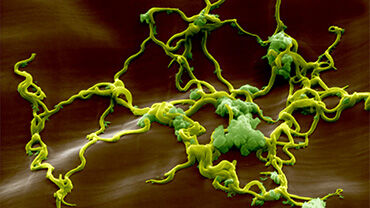Pathogens and symbionts in ticks: a survey on tick species distribution and presence of tick-transmitted micro-organisms in Sardinia, ItalyArchived
In this paper, the authors present results produced by a two-year screening study on ticks from Sardinia for different tick-associated pathogens. They show that Rhipicephalus sanguineus is predominant and presents the most important diversity of pathogens, with its counterpart Rhipicephalus turanicus.
Satta G, Chisu V, Cabras P, Fois F, Masala G.Istituto Zooprofilattico Sperimentale della SardegnaJournal of Medical Microbiology, 2010 Sep 30, ahead of print, doi:10.1099/jmm.0.021543-0
A total of 1485 adult ticks were collected from mammal hosts in Southeastern Sardinia, Italy, during the years 2007-2008. Ticks were identified and tested by PCR analysis for presence of Rickettsia spp. of the spotted fever group (SFG), Ehrlichia canis, Anaplasma phagocytophilum, Coxiella burnetii, Bartonella spp. and Leishmania spp.. Among all tick species examined (Rhipicephalus sanguineus, Rhipicephalus turanicus, Rhipicephalus bursa, Rhipicephalus pusillus, Hyalomma marginatum marginatum, Haemaphisalis sulcata and Dermacentor marginatus), only H. marginatum marginatum produced negative results. A total of 22 pools belonging to the three tick species R. sanguineus (0.9%), R. turanicus (4.5%), and R. pusillus (100%) were positive for Rickettsia spp., while a total of 5 pools belonging to R. sanguineus (0.09%), H. sulcata (16.7%), and D. marginatus (7.8%) were positive for E. canis. 5 pools of R. turanicus (1.8%) were positive for A. phagocytophilum. Positivity for C. burnetii was found in 7 pools belonging to three tick species: R. sanguineus (0.5%), R. turanicus (0.3%) and H. sulcata (4.4%). Finally, 4 pools belonging to R. sanguineus (0.09%), R. turanicus (0.7%), and R. bursa (1.1%) were positive for Bartonella spp.. Leishmania spp. DNA was not detected in any of the tick pools examined. Data presented here increase our knowledge on tick-borne diseases in Sardinia, and provide a useful contribution to understanding their epidemiology.
VBORNET comment: 2010-12-07
In this paper, the authors present results produced by a two-year screening study on ticks from Sardinia for different tick-associated pathogens. They show that Rhipicephalus sanguineus is predominant and presents the most important diversity of pathogens, with its counterpart Rhipicephalus turanicus. They also confirm host preferences of ticks, as previously described. This descriptive work gives some useful data on tick presence and tick-associated pathogens in Sardinia. However, it seems ambiguous from the authors to announce a survey on tick distribution since only two zones of Sardinia have been examined and are treated together for the result interpretation. It is also astonishing that PCR for at least Wolbachia were not realized while the authors propose a survey of tick symbionts.





